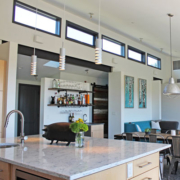Daylight: Come to Life!
Bluebell Home: Light and transparency interact in a light filled in-town living space.
By David Barrett, FAIA
On many mornings I sit in a café where daylight surrounds the lives that come and go. Caffeine serves as a temporary agent of our awakening; we are warmed inside by a quiet moment, conversations, a new day. I watch as the light dances beautifully across faces, subtle expressions revealing an inner response that might have been missed sitting in a darker corner.
I am hopelessly smitten with light. As an architect, I am the privileged manipulator of light space. Daylight in particular informs our moods, our sense of connection to the cycles of the day, and touches the “awe button”. Doesn’t it take your breath away?
Aside from daylight being naturally energy conserving, I was struck by some current health care research that crossed my desk.
Are you in favor of these?
- Better sleep quality
- Reduced agitation
- Better pain management
- A shorter hospital stay
Research shows these are all benefits of increased access to daylight in the health care environment.
Architectural space comes to life in natural daylight, and apparently so do we.
Examples of day lighting in Barrett Studio projects
Artists Home and Studios: East Hampton, N.Y. artists create in day lit studios that speak to their individual desires for light, color and going inward. Translucent Polygal clearstory windows invite the light of creativity.
Phoenix Home: Sweeping mountain views are brought into visual balance by way of soft daylight introduced from above.
Abbey of St. Walburga: The light of heaven and earth speaks of transcendence for monastic prayer in the chapel of the Abbey of St. Walburga. Mystical light illuminates the incense to create a sense of mystery and spirit.
Uncompahgre Retreat: Quality of daylight gives visual clarity and sense of time and place.
Home on the Range: The rhythm of daylight directs one’s path while giving context for art as well as passage.
Little Ship House: Layers of structure and light suggest the protection of the archetypal cabin, while lifting our sense of connection to the light and time of day, the seasons, and climate. Natural light provides a sense of well-being.
Wee Ski Chalet: Sitting in the snowy woods in the warmth of direct sunshine, passive solar provides illumination to the ochre interiors in a warming glow.
Healthcare Benefits Research
Sundolier, Inc. gathered this current research on daylight in the health care environment:
“Female patients in a cardiac ICU exhibited shorter length of stay in sunny rooms.”
Source: Journal of the Royal Society of Medicine
“Hospital patients with access to daylight have better sleep quality, reduced agitation and better pain management.”
Source: Architectural Engineering Design Group, Inc.
“Insufficient or inappropriate light exposure can disrupt normal circadian rhythms which may result in adverse consequences for human performance, health and safety.”
Source: LEUKOS – The Journal of the Illuminating Engineering Society of North America, vol 5 (1), pp. 1-26, July 2008.
“Patients residing in a hospital exposed to 46% higher intensity sunlight on average took 22% less analgesic medicine than counter parts with similar medical conditions on the darker side of the hospital – resulting in a 21% cost differential.”
Source: Psychosomatic Medicine


































Leave a Reply
Want to join the discussion?Feel free to contribute!